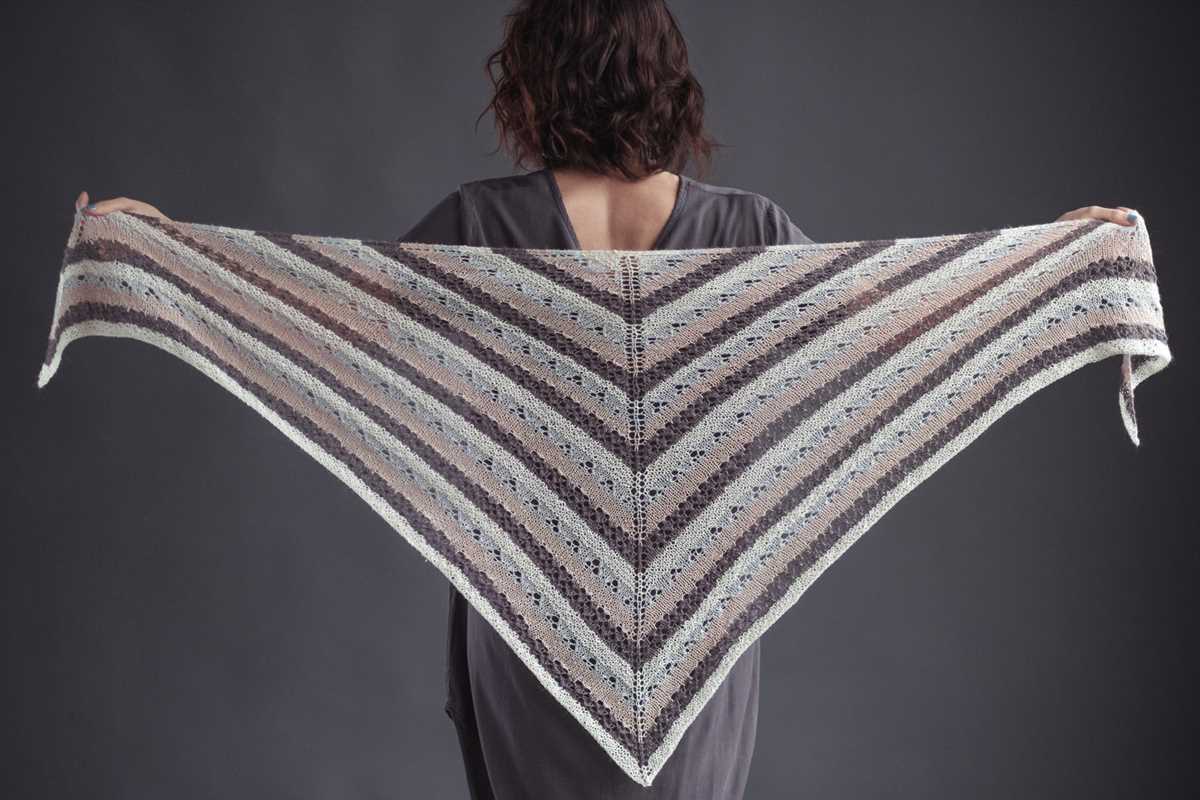
Shawls are a versatile and stylish accessory that can add a touch of elegance to any outfit. Whether you’re dressing up for a special occasion or simply want to stay cozy on a chilly evening, a knitted shawl is the perfect choice. And the best part? There are plenty of free knitting patterns available online, so you can create your own beautiful shawl without breaking the bank.
If you’re new to knitting, don’t worry – there are patterns available for beginners as well as more advanced knitters. From simple garter stitch shawls to intricate lace designs, you’re sure to find a pattern that suits your skill level and personal style. Knitting a shawl can be a relaxing and rewarding project, allowing you to explore different stitches and techniques while creating something truly unique.
With a wide variety of yarn weights and colors to choose from, you can customize your shawl to match any outfit or occasion. Whether you prefer a chunky shawl for added warmth or a delicate lace design for a touch of femininity, there’s a pattern out there for you. So grab your knitting needles and get started on your next shawl project – you’ll be amazed at the beautiful results you can achieve!
Shawls to Knit Free Patterns
If you’re looking for beautiful and versatile shawls to knit, you’re in luck! We have compiled a list of free patterns that will inspire and challenge you. Whether you’re a beginner knitter or an advanced one, these patterns offer something for everyone.
One of the most popular shawl patterns is the Triangle Shawl. This classic design is perfect for incorporating different stitch patterns and color combinations. The pattern typically starts from the center and increases on both sides to create a triangular shape. It can be worked in a single color or with stripes for a more dynamic look.
Another beloved shawl design is the Lace Shawl. This pattern features intricate lace motifs that add elegance and sophistication to your knitting. The openwork allows for extra drape and lightness, making it a perfect accessory for any outfit. The best part is that you can adjust the size of the shawl by adding or removing pattern repeats.
If you’re looking for a quick and easy project, try the Garter Stitch Shawl. This pattern is perfect for beginners as it only requires the basic garter stitch. The simplicity of the design allows for endless possibilities for experimenting with different yarns and colors. You can also add tassels or fringe for an extra touch of whimsy.
For a modern twist on the traditional shawl, try the Colorblock Shawl. This pattern features bold color blocking that adds a contemporary flair to your knitting. You can play with different color combinations and create a unique accessory that will make a statement. The pattern often includes sections of garter stitch, stockinette stitch, and slipped stitches for added texture.
These are just a few examples of the many shawls to knit free patterns available. Whether you prefer classic or contemporary designs, there’s something out there for you. So grab your needles and get knitting!
Beginner’s Guide to Knitting Shawls
Knitting shawls can be a fun and rewarding project for beginners. With just a few basic knitting techniques, you can create beautiful and cozy shawls to keep yourself or your loved ones warm. Here is a beginner’s guide to get you started on your knitting journey.
Choose the Right Yarn and Needles
When knitting shawls, it’s important to choose the right yarn and needles. For beginners, it’s recommended to start with medium-weight yarn and size 8 or 9 knitting needles. This combination will make it easier for you to handle the yarn and stitches, allowing you to focus on learning the basic techniques.
Start with Simple Patterns
As a beginner, it’s best to start with simple shawl patterns that require only the basic knitting stitches. Look for patterns that use garter stitch, stockinette stitch, or simple lace patterns. These patterns will help you practice the fundamental knitting techniques while creating a beautiful shawl.
Learn the Basic Stitches
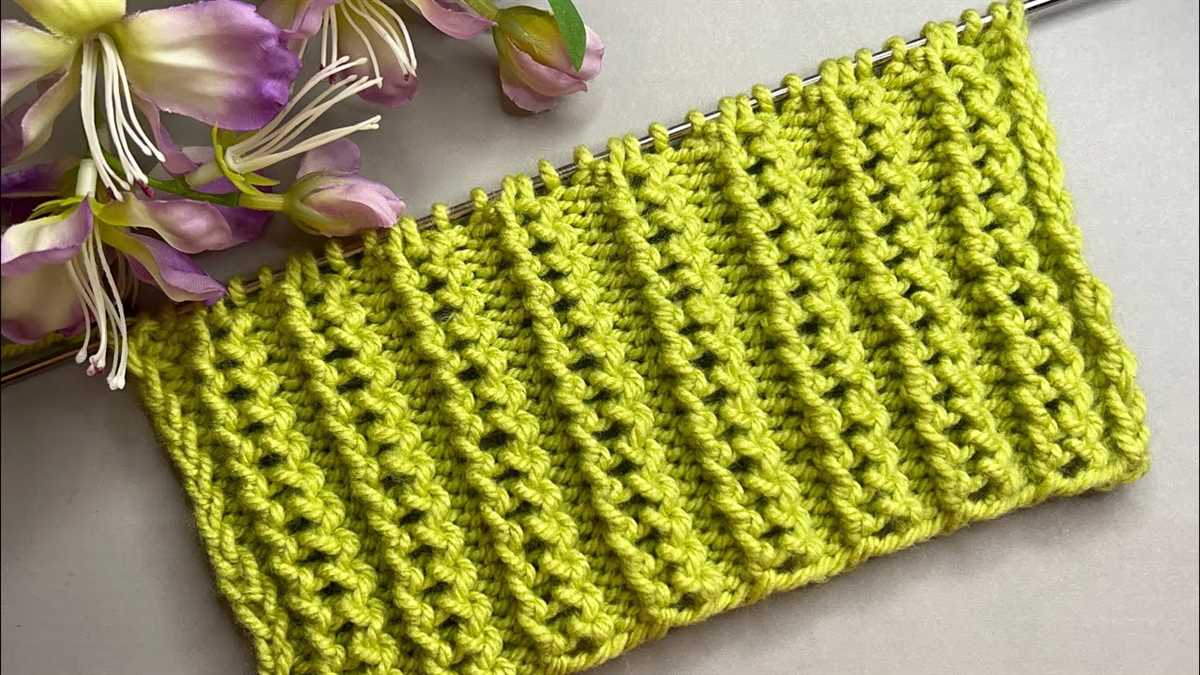
Before you start knitting your shawl, it’s important to learn the basic knitting stitches. The two essential stitches for knitting shawls are the knit stitch (k) and the purl stitch (p). These stitches create the foundation for various knitting patterns and designs.
Follow the Pattern Instructions
When knitting shawls, it’s crucial to carefully read and follow the pattern instructions. Pay attention to the stitch counts, stitch markers, and any special techniques or abbreviations used in the pattern. Following the instructions will ensure that your shawl turns out as intended.
Practice Patience and Perseverance
Knitting shawls can be a time-consuming process, especially for beginners. It’s important to practice patience and persevere through any challenges or mistakes that may arise. Remember, knitting is a skill that improves with practice, so don’t get discouraged if your first shawl doesn’t turn out perfect. Keep knitting and learning, and soon you’ll be creating stunning shawls!
With this beginner’s guide, you’re ready to start knitting your own shawls. Remember to choose the right yarn and needles, start with simple patterns, learn the basic stitches, follow the pattern instructions, and practice patience and perseverance. Happy knitting!
Why Shawls Are a Must-Have in Your Wardrobe
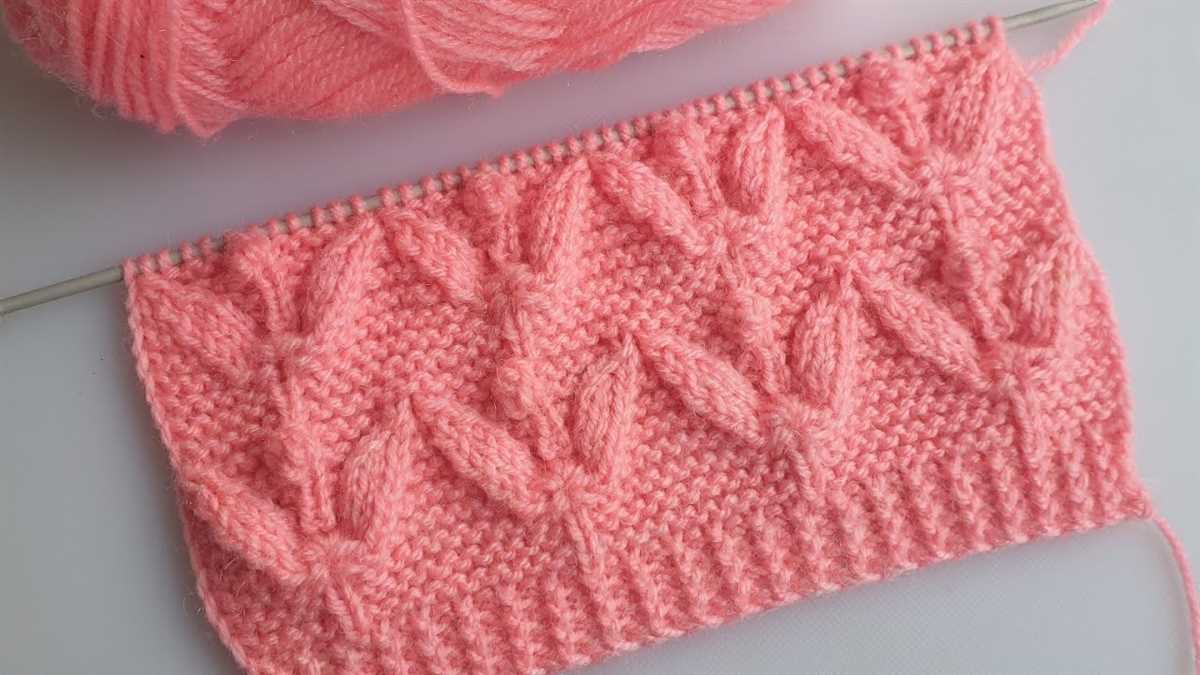
Shawls are versatile fashion accessories that can add a touch of elegance and style to any outfit. They come in a wide variety of patterns, colors, and fabrics, making them a must-have item in your wardrobe. Whether you’re dressing up for a formal event or just running errands, a shawl can instantly elevate your look and make you feel more put together.
One of the main reasons why shawls are so popular is their versatility. They can be worn in many different ways, allowing you to change up your look depending on the occasion. You can drape a shawl over your shoulders for a more traditional look, or wrap it around your neck like a scarf for a more casual and cozy appearance. The possibilities are endless, and with a little creativity, you can create unique and stylish outfits.
A shawl can also be a practical accessory, especially during the colder months. It provides an extra layer of warmth and can help to keep you cozy on chilly days. Additionally, shawls can be easily folded and packed, making them ideal for traveling or keeping in your bag for when you need an extra layer on the go.
Furthermore, knitting your own shawls can be a rewarding and enjoyable hobby. There are countless free patterns available online, allowing you to create unique and personalized shawls that reflect your style and taste. Knitting can also be a relaxing and therapeutic activity, providing a break from the stresses of daily life.
In conclusion, shawls are a versatile and essential item in any wardrobe. They can add style and elegance to any outfit, provide warmth during colder months, and can be a fun and rewarding project to knit your own. Consider adding a few shawls to your collection and enjoy the benefits they bring to your style and comfort.
Choosing the Right Yarn for Knitting Shawls
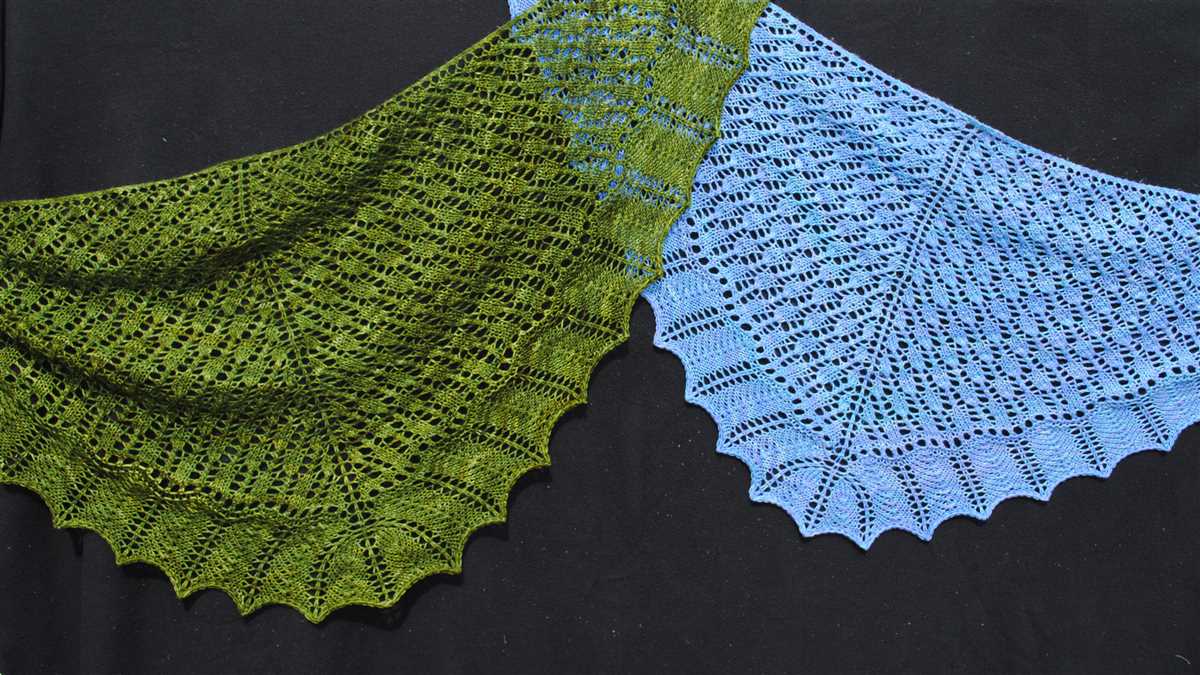
When it comes to knitting shawls, one of the most important decisions you’ll need to make is choosing the right yarn. The type of yarn you choose will greatly affect the final look and feel of your shawl, as well as its drape and warmth. Here are some factors to consider when selecting yarn for your shawl project.
Fiber Content
The first thing to consider is the fiber content of the yarn. Different fibers have different characteristics, so it’s important to choose one that suits your needs and preferences. For example, if you’re looking for a shawl with great drape, you might want to choose a yarn that contains silk or bamboo. On the other hand, if you’re looking for a shawl that’s warm and cozy, you might opt for a yarn that contains wool or alpaca.
Weight and Gauge
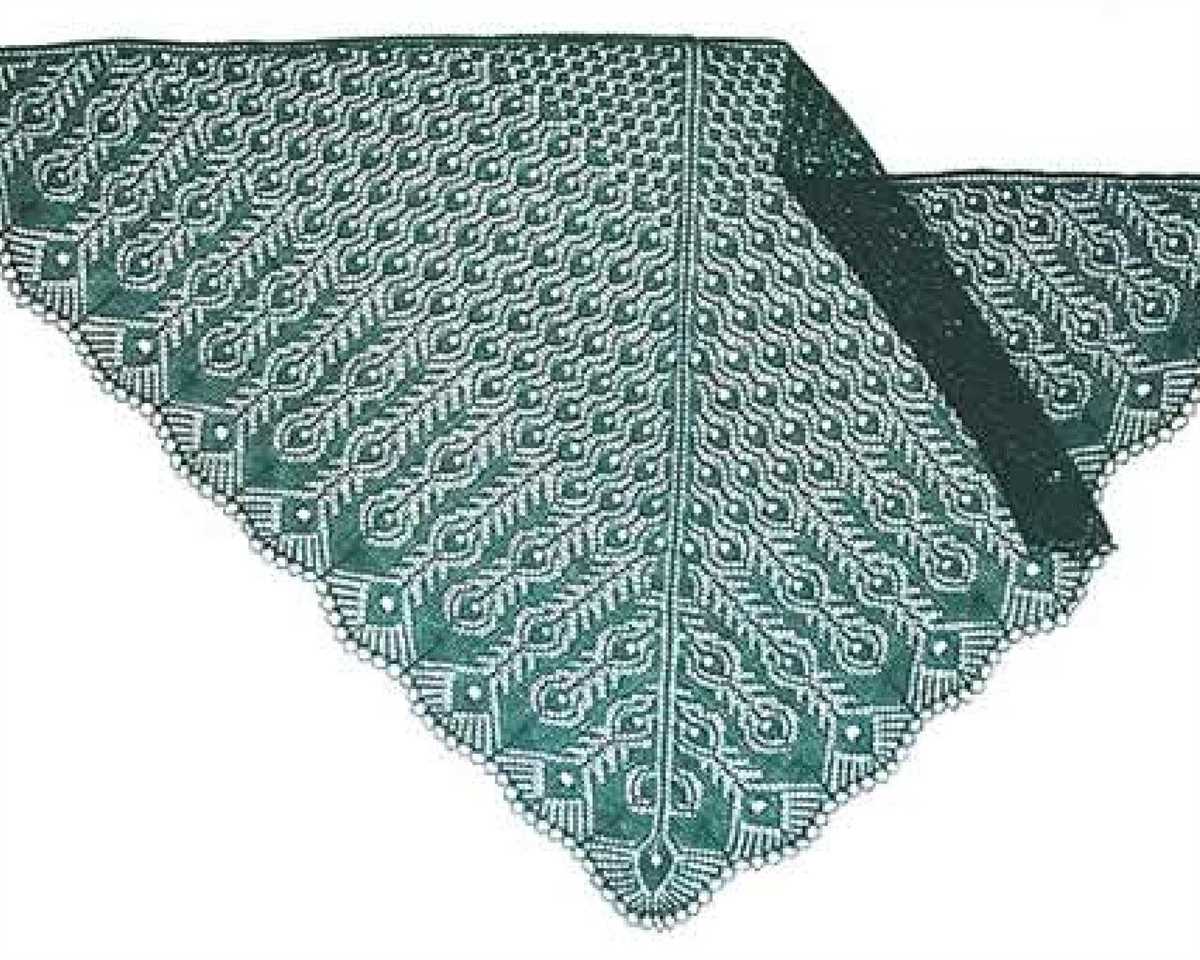
The weight of the yarn you choose will also impact the final outcome of your shawl. Lighter weight yarns will create more delicate and airy shawls, while heavier weight yarns will result in thicker, chunkier shawls. Additionally, the gauge of the yarn will determine the size of your stitches and the overall size of your shawl. Be sure to follow the recommended gauge for your chosen pattern to ensure the best results.
Color and Texture
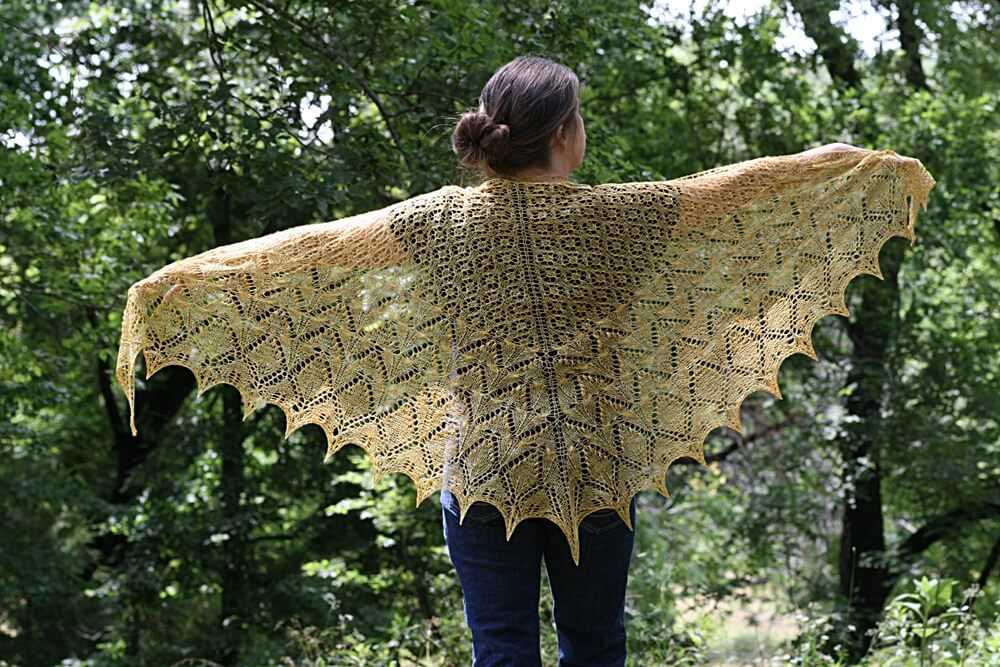
Finally, consider the color and texture of the yarn. The color of your yarn will greatly impact the overall look of your shawl, so choose one that complements your personal style and wardrobe. Additionally, the texture of the yarn can add interest and dimension to your shawl. Consider whether you want a smooth and sleek yarn or one with more texture, such as a boucle or mohair yarn.
By taking into account the fiber content, weight and gauge, as well as the color and texture of the yarn, you’ll be able to choose a yarn that is perfect for knitting your shawl. Remember, each yarn has its own unique qualities, so don’t be afraid to experiment and try different yarns to achieve the desired look and feel for your shawl project.
Essential Knitting Techniques for Shawl Patterns
When it comes to knitting shawls, there are several techniques that every knitter should know. Whether you’re a beginner or an experienced knitter, mastering these essential techniques will help you create beautiful shawls. Here are a few techniques to get you started:
1. Casting On and Binding Off:
The first step in any knitting project is casting on, which creates the initial row of stitches on your needles. For shawls, you can use a variety of cast-on methods depending on the desired edge. Some common cast-on methods for shawls include the long-tail cast-on and the provisional cast-on. Similarly, binding off is the final step in finishing your shawl and securing the last row of stitches. The standard bind-off method is commonly used for shawls, but you can also experiment with other bind-off methods to achieve different effects.
2. Increases and Decreases:
Increases and decreases are essential for shaping your shawl. Common increase methods include yarn overs (YO) and make one (M1) stitches, which add stitches to your work. Decrease methods, such as knit two together (K2tog) and slip, slip, knit (SSK), are used to reduce the stitch count and create shaping. Understanding how to execute these increases and decreases will allow you to create intricate lace patterns and shaping in your shawl.
3. Lace Knitting:
Lace knitting is a common technique used in shawl patterns to create delicate and intricate designs. It involves working yarn overs, decreases, and knit stitches to form open and airy patterns. When knitting lace, it’s important to keep track of stitch counts and pattern repeats to ensure accuracy. Using stitch markers can be helpful in marking specific points in the pattern and making it easier to spot any mistakes.
4. Blocking:
Blocking is the process of shaping and stretching your finished knitted piece to achieve the desired size and shape. For shawls, blocking is essential to open up lace patterns and give the shawl its final drape. There are different blocking methods, including wet blocking and steam blocking, depending on the fiber content of your shawl. Blocking wires, pins, and a blocking mat are useful tools for ensuring your shawl dries evenly and maintains its shape.
By mastering these essential knitting techniques, you’ll be well-equipped to tackle a variety of shawl patterns. Remember to practice and experiment with different stitches and patterns to unleash your creativity and create stunning shawls.
Five Easy Free Shawl Patterns for Beginners
If you’re new to knitting and want to try your hand at making a shawl, there are many free patterns available that are perfect for beginners. These patterns are simple and easy to follow, making them a great introduction to shawl knitting. Whether you prefer a lacy design or a cozy, textured piece, there’s a pattern out there for you. Here are five easy free shawl patterns to get you started:
1. Garter Stitch Shawl:
The garter stitch shawl is a classic and basic pattern that is perfect for beginners. It is worked entirely in garter stitch, which means you only need to know how to knit. This pattern is great for practicing your knitting skills and creating a versatile and cozy shawl that can be worn in various ways.
2. Simple Lace Shawl:
If you’re ready to try your hand at lace knitting, a simple lace shawl is a great choice. Look for a pattern with easy-to-follow lace stitches and clear instructions. This type of shawl will introduce you to yarnovers and basic lace stitches while creating a beautiful, lightweight accessory.
3. Triangle Shawl:
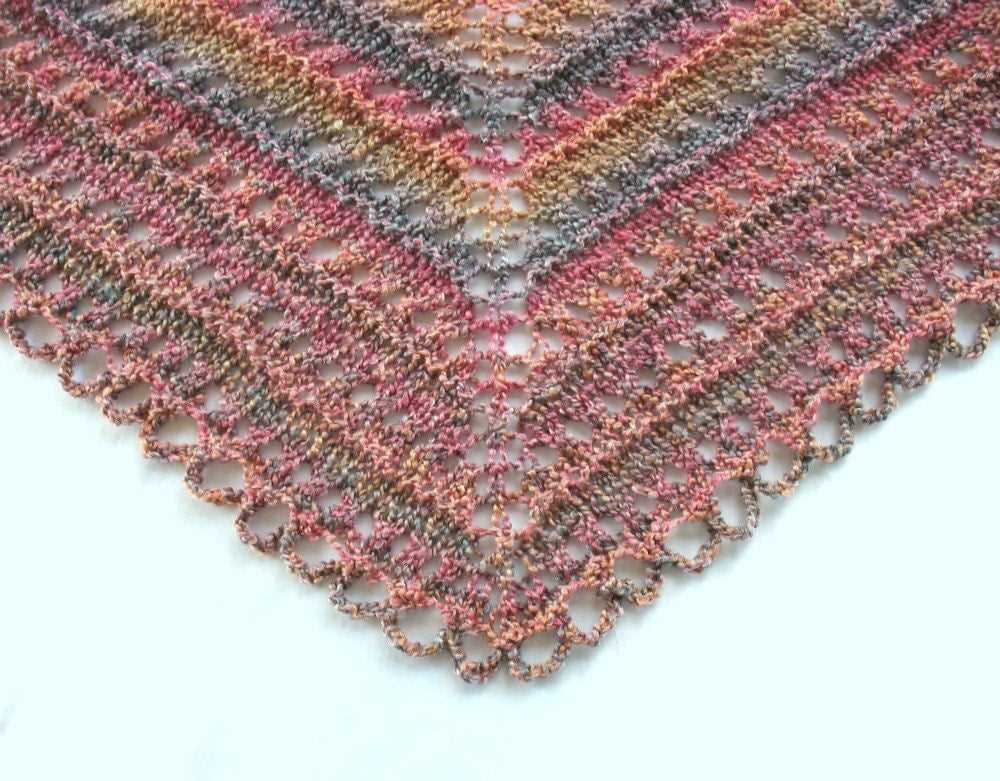
A triangle shawl is another popular option for beginners. This type of shawl is worked from the top down, starting with just a few stitches and increasing as you go. It’s a great way to learn basic shaping techniques and create a versatile and stylish accessory.
4. Colorful Striped Shawl:
If you’re looking to add some color to your knitting, a colorful striped shawl is a great choice. Look for a pattern that uses simple color changes and easy techniques to create stunning stripes. This type of shawl is a fun and creative way to experiment with different color combinations and create a unique accessory.
5. Textured Shawl:
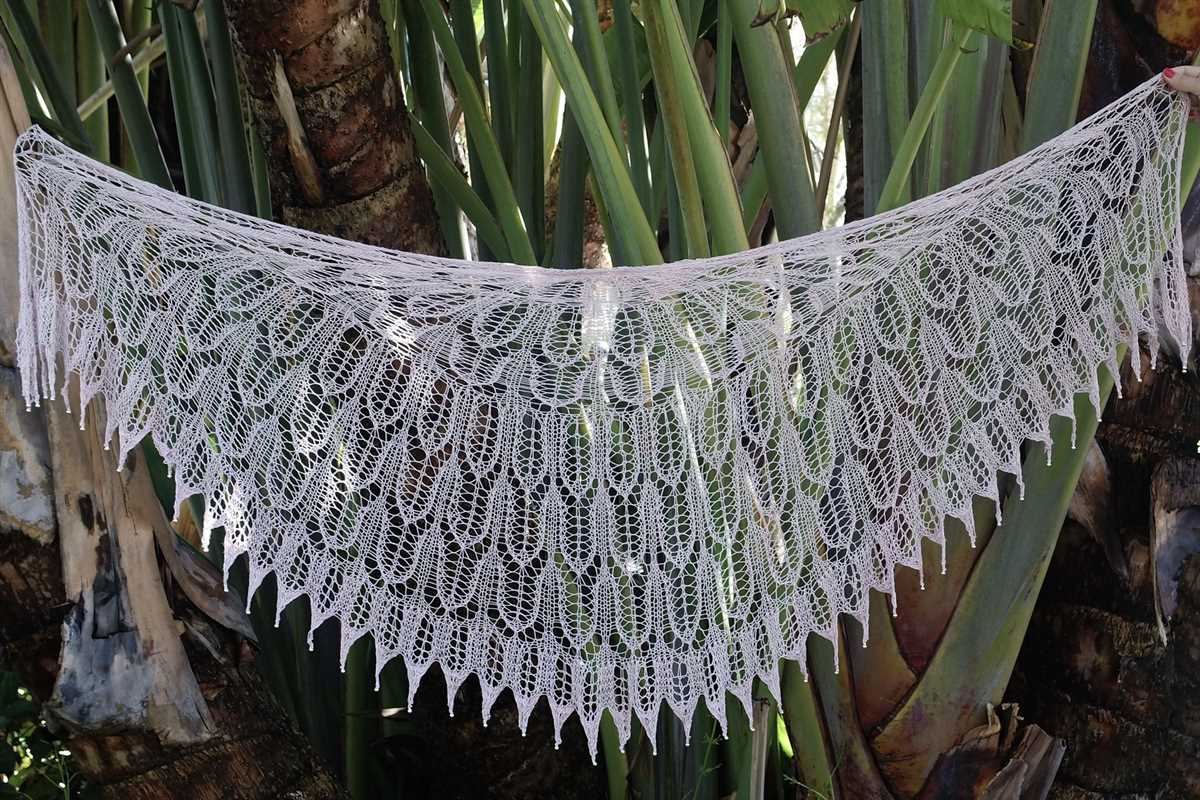
If you prefer a shawl with some texture, a pattern with textured stitches is a good option. Look for patterns that use simple stitch patterns like ribbing, seed stitch, or moss stitch to add texture and interest to your shawl. This type of shawl is a great way to practice different stitch patterns and create a cozy and unique accessory.
With these five easy free shawl patterns, you’ll be able to create beautiful and unique accessories while practicing your knitting skills. Whether you prefer a simple garter stitch shawl or a more textured design, there’s a pattern out there that’s perfect for you. So grab your needles and some yarn, and start knitting your first shawl today!
Stylish Lace Shawl Patterns to Knit
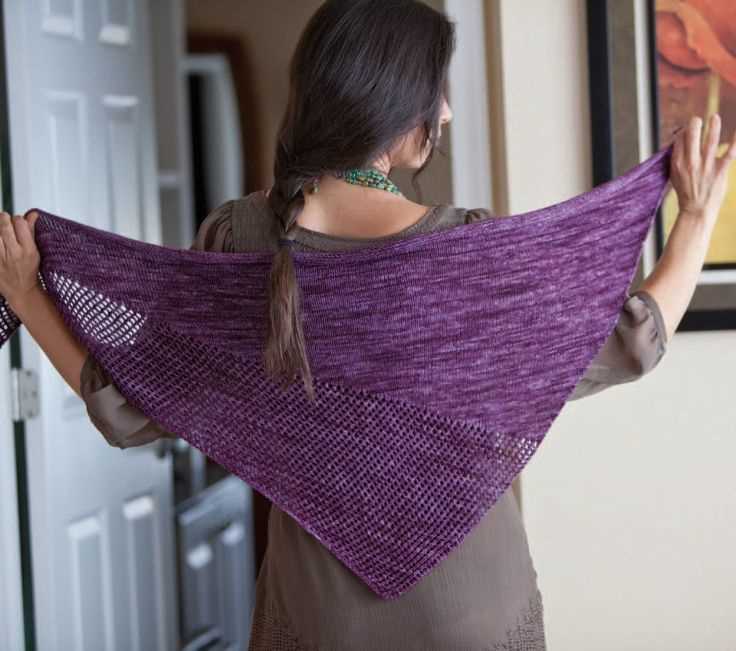
Lace shawls are a timeless and versatile accessory that every knitter should have in their repertoire. Whether you want to add a touch of elegance to your outfit or cuddle up with a cozy wrap on a chilly evening, lace shawls are the perfect choice. With their intricate patterns and delicate texture, they can be both delicate and eye-catching, making them a stylish addition to any wardrobe.
If you’re looking for free knitting patterns for lace shawls, you’re in luck. There are plenty of beautiful designs available that range from beginner-friendly to more advanced. Whether you’re a beginner or an experienced knitter, you can find a lace shawl pattern that suits your skill level and style.
One popular lace shawl pattern is the “Feather and Fan” design. This classic pattern features a repeating motif of feathers and fans, creating a delicate and airy fabric. The openwork lace pattern is perfect for showcasing the beauty of fine yarns, and the finished shawl is lightweight and comfortable to wear.
If you’re looking for something more intricate, the “Peacock Feather” lace shawl pattern is a stunning choice. Inspired by the delicate feathers of a peacock, this pattern features a complex lace motif that creates a beautiful and eye-catching fabric. The finished shawl is sure to turn heads and make a statement.
With so many beautiful lace shawl patterns available, you’re sure to find the perfect design to knit. Whether you prefer a classic and simple style or a more intricate and detailed design, lace shawls offer endless opportunities for creativity and expression. So grab your knitting needles and yarn, and start creating your own stylish lace shawl today!
Cozy and Warm Cable Knit Shawl Patterns
If you’re looking to stay warm and cozy during the colder months, cable knit shawls are the perfect accessory. These patterns feature intricate cable designs that not only add visual interest but also provide extra warmth. Whether you’re a beginner or an experienced knitter, you’ll find a cable knit shawl pattern that suits your skill level and style.
One popular cable knit shawl pattern is the “Cabled Comfort.” This pattern features a wide cable design in the center, surrounded by smaller cables on each side. The shawl is knit using bulky yarn, making it extra warm and snuggly. With its classic cable design, this shawl is perfect for both casual and formal occasions.
If you’re looking for a more unique cable knit shawl pattern, try the “Twisted Elegance.” This pattern features a combination of twisted cables and lace stitches, creating a delicate and feminine look. The shawl is worked from the center out, and the pattern includes both written instructions and a chart. This shawl is perfect for adding a touch of elegance to any outfit.
Materials needed:
- Size 10 knitting needles
- DK weight yarn
- Cable needle
- Tapestry needle
Another option is the “Chunky Cable Wrap.” This pattern features a chunky cable design that adds texture and dimension to the shawl. The wrap is knit using super bulky yarn, making it incredibly warm and cozy. With its oversized fit, this shawl is perfect for wrapping yourself up on those chilly winter days.
Whether you prefer classic or unique designs, cable knit shawls are a great way to add warmth and style to your wardrobe. With the right materials and a bit of practice, you can create a cozy and warm shawl that will keep you snug all winter long.
Knitting Shawls with Variegated Yarn: Tips and Tricks
When it comes to knitting shawls, using variegated yarn can add a unique and beautiful touch to your project. However, working with variegated yarn can present its own set of challenges. Here are some tips and tricks to help you make the most out of your variegated yarn when knitting shawls.
1. Choose the Right Pattern
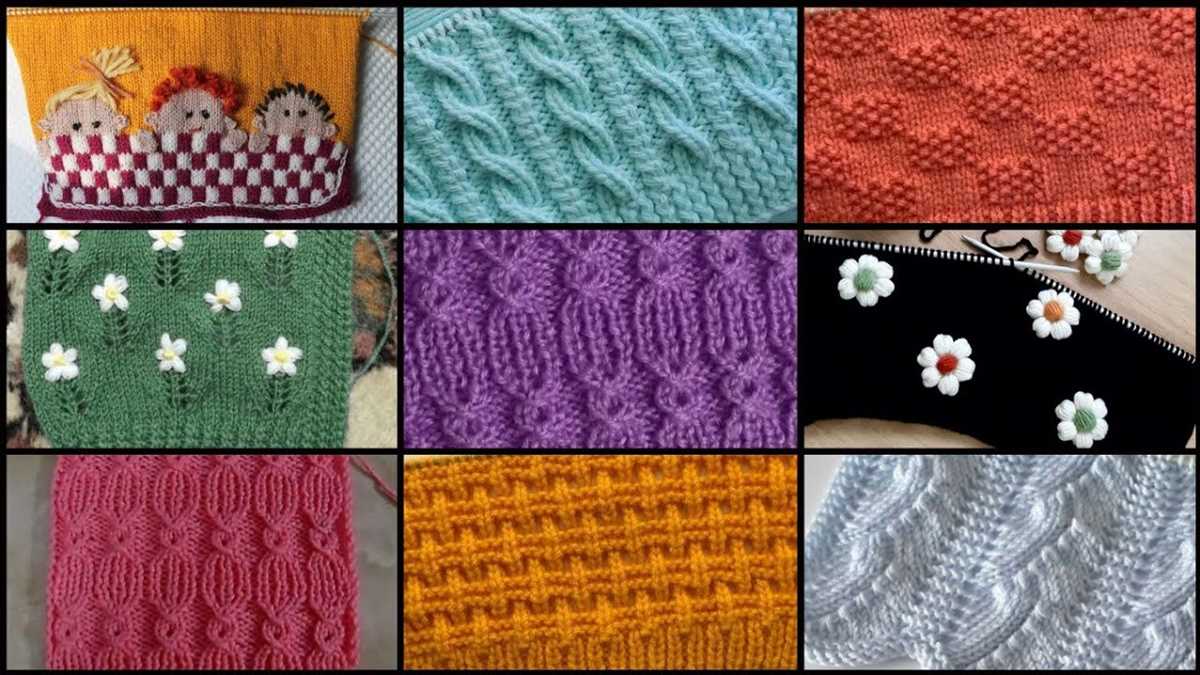
When selecting a pattern for your shawl, consider how the colors in the variegated yarn will play out. Look for patterns that highlight the color changes in the yarn or incorporate stitch patterns that will complement the variegation. For example, lace or cable patterns can create an interesting contrast with the multi-colored yarn.
2. Swatch and Experiment
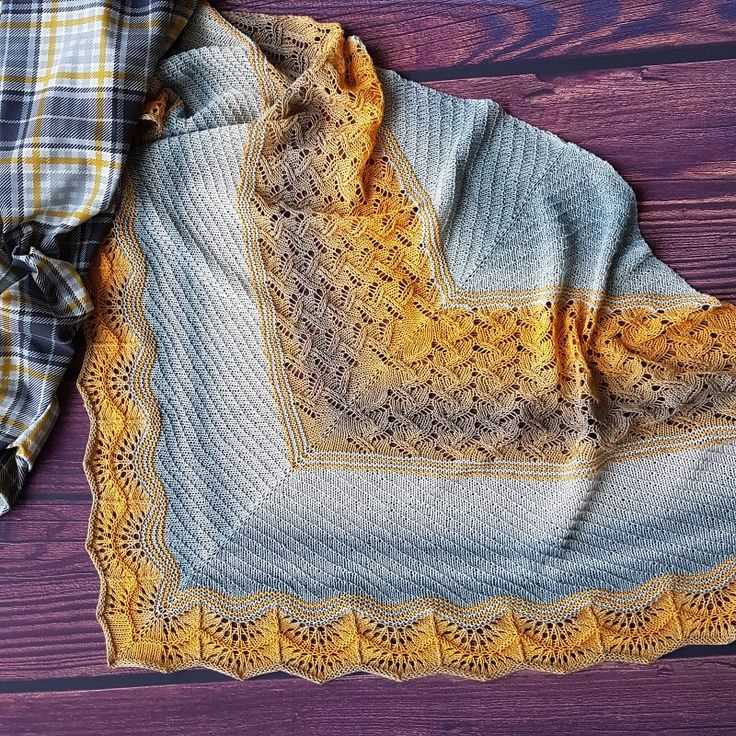
Before diving into your shawl project, it’s essential to swatch and experiment with your variegated yarn. Different colors may pool or create an undesirable effect when knitted up, so by swatching, you can see how the colors will behave in the chosen stitch pattern. If you’re not happy with how the colors are pooling or distributing, you can adjust your needle size or try a different stitch pattern.
3. Consider Gradient or Self-Striping Yarn
If you’re unsure about working with variegated yarn, you can opt for gradient or self-striping yarn instead. Gradient yarns transition between different shades of the same color, while self-striping yarns change color in regular intervals. These types of yarns can add visual interest to your shawl without the complexity of working with variegated yarn.
4. Use Simple Stitch Patterns
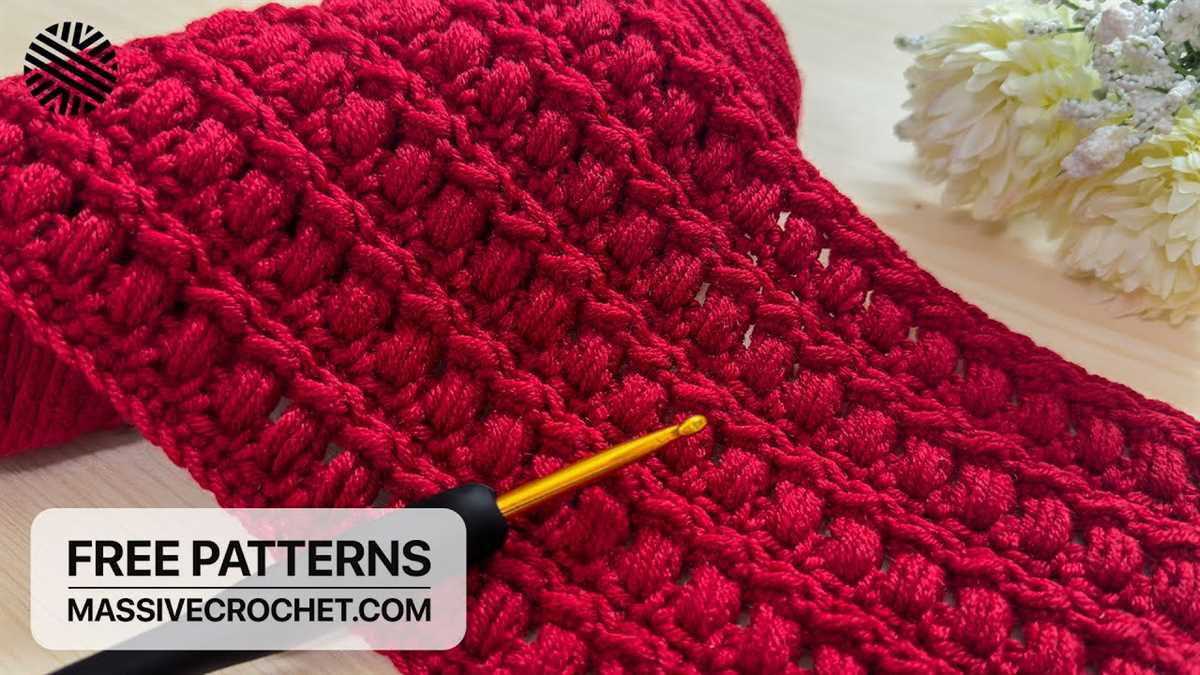
When working with variegated yarn, it’s best to choose simple stitch patterns that won’t compete with the colors in the yarn. Garter stitch or stockinette stitch can allow the variegation to shine and create a beautiful drape in your shawl. Additionally, simple stitch patterns make it easier to keep track of color changes and avoid any unwanted pooling.
5. Embrace the Unexpected
One of the joys of working with variegated yarn is the element of surprise. Each skein can create unique patterns and color combinations, making every shawl a one-of-a-kind creation. Embrace the unexpected and have fun experimenting with different colorways. The beauty of variegated yarn is in its unpredictability, so let it inspire you and enjoy the process of knitting a truly unique shawl.
Shawl Patterns for Different Seasons and Occasions
Shawls are versatile accessories that can be worn throughout the year, providing warmth and style for different seasons and occasions. Whether you are looking for a lightweight shawl for the summer or a cozy wrap for the winter, there are numerous free knitting patterns available to suit your needs.
1. Spring Shawls: When the weather starts to warm up, you may want a shawl that provides just a touch of warmth. Look for patterns that feature lighter yarns such as cotton or bamboo, and opt for lacy designs that allow for breathability. A spring shawl can add a pop of color to your outfit and be the perfect accessory for a garden party or an evening stroll.
2. Summer Shawls: During the hot summer months, you may still want a shawl for those cool evenings or air-conditioned spaces. Choose patterns that use lightweight yarns such as linen or silk, and opt for open stitch patterns that allow for maximum ventilation. A summer shawl can be worn as a beach cover-up or paired with a sundress for a chic and feminine look.
3. Fall Shawls: As the leaves start to change color and the weather gets cooler, it’s time to bring out the cozy shawls. Look for patterns that use heavier yarns such as wool or alpaca, and opt for textured stitch patterns that add warmth and depth. A fall shawl can be worn as a statement piece with your favorite sweater or jacket, or draped over your shoulders for a touch of elegance at a formal event.
4. Winter Shawls: When the cold weather sets in, a thick and warm shawl becomes a must-have accessory. Choose patterns that use bulky or super bulky yarns, and opt for cable or colorwork designs that provide extra insulation. A winter shawl can be wrapped around your neck for added warmth or worn as a shoulder wrap over a coat for a stylish and cozy look.
With the abundance of free knitting patterns available, you can easily find the perfect shawl pattern for any season or occasion. Whether you prefer lace, cables, or simple garter stitch, there is a shawl pattern out there that will showcase your knitting skills and keep you stylishly warm all year round.
How to Customize and Modify Shawl Patterns
Knitting shawls is a popular and fulfilling hobby for many. However, sometimes you may find a knitting pattern for a shawl that you like, but it doesn’t quite fit your preferences or requirements. In such cases, customizing and modifying shawl patterns can be a great solution. With a few simple changes, you can transform any shawl pattern into a unique and personalized masterpiece.
1. Adjusting the Size: One of the most common modifications you may want to make is adjusting the size of the shawl. Whether you prefer a smaller, more lightweight shawl or a larger, cozy wrap, you can easily modify the pattern to suit your needs. You can do this by adding or subtracting stitches or rows, or by changing the yarn weight and needle size to achieve the desired dimensions.
2. Changing the Stitch Pattern: Another way to customize a shawl pattern is to change the stitch pattern. If you find a pattern you love, but prefer a different stitch pattern or texture, you can substitute it with another stitch pattern that you like. You can experiment with lace patterns, cables, or other textured stitch patterns to create a shawl that is truly unique to you.
3. Adding or Removing Edgings: Edgings can add an extra touch of beauty and elegance to a shawl. If you want to customize your shawl by adding or removing edgings, you can do so by modifying the pattern accordingly. You can add a picot edging, a ruffle, or a different type of lace edging to give your shawl a different look. On the other hand, if you prefer a simpler, cleaner edge, you can remove the edging altogether.
4. Playing with Color: Color can make a big difference in the overall look of a shawl. If you want to customize your shawl by playing with color, you can choose different shades or hues of yarn to create a unique color palette. You can also experiment with color-blocking techniques or create striped patterns to add visual interest to your shawl.
Remember, when customizing and modifying shawl patterns, it’s important to keep track of your changes and make notes for future reference. This way, you can recreate your modifications or share them with others who may be interested in knitting the same shawl. Customizing and modifying shawl patterns allows you to unleash your creativity and create a shawl that is truly one-of-a-kind.
Finishing Touches: Blocking and Finishing Your Knitted Shawls
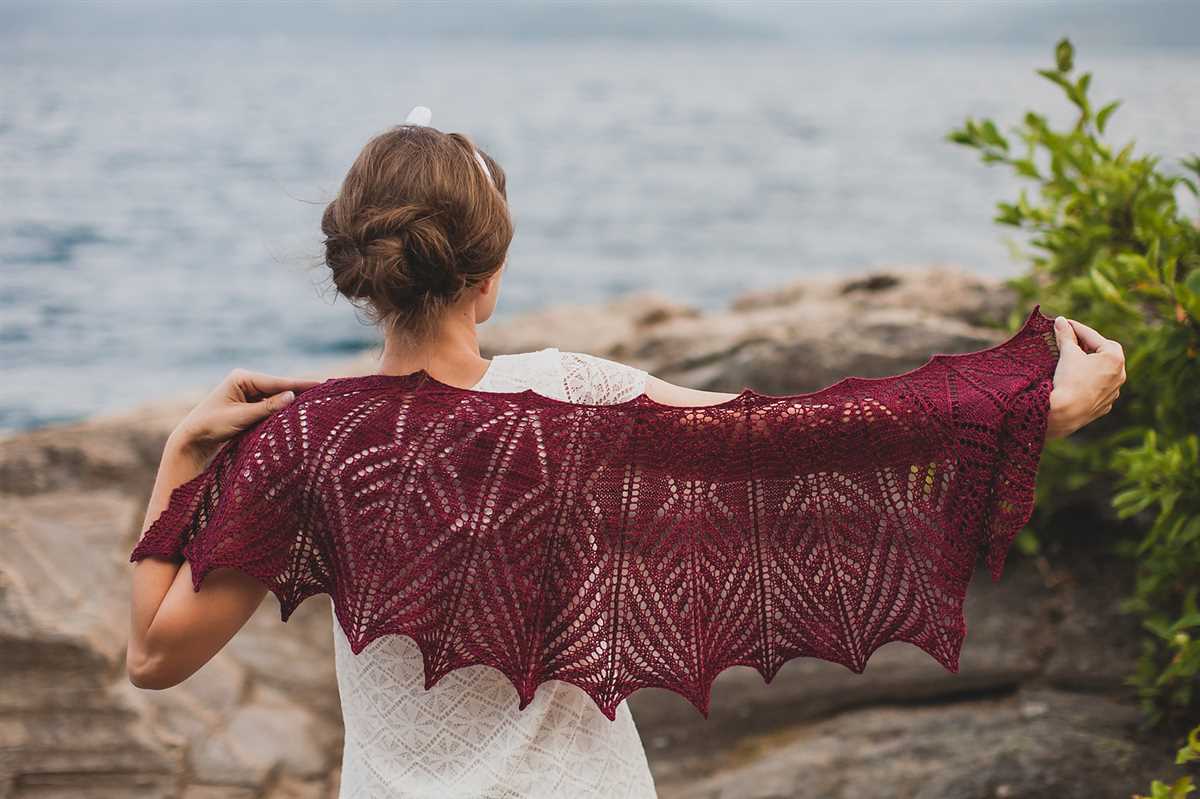
Once you have finished knitting your shawl, there are a few important steps to take to give it that polished look. Blocking and finishing your knitted shawl will help to even out the stitches, open up lace patterns, and give your shawl its final shape.
Blocking:
Blocking is the process of shaping and stretching your knitted shawl into its final dimensions. To block your shawl, you will need a large, clean surface, such as a blocking board or an ironing board, and some blocking pins or T-pins.
Start by soaking your shawl in lukewarm water with a gentle wool wash or mild detergent. Gently squeeze out the excess water, being careful not to wring or twist the shawl. Lay the shawl flat on your blocking surface, and use the pins to stretch and shape the shawl to its desired dimensions.
If your shawl has lace or openwork patterns, use the pins to open up the stitches and define the lace motifs. Leave the shawl to dry completely before removing the pins.
Finishing:
Once your shawl is dry, it is time to finish off any remaining details. This can include weaving in loose ends, sewing on any additional embellishments such as beads or buttons, or adding fringe.
If your shawl has fringe, you can attach it by cutting several strands of yarn to the desired length, and then attaching them to the edge of the shawl by tying knots or using a crochet hook. Trim the fringe evenly if necessary.
Summary:
Blocking and finishing are essential steps in completing your knitted shawl. Blocking will help to shape and even out the stitches, while finishing adds those final touches and details. By taking the time to block and finish your shawl, you will ensure that it looks its best and is ready to be worn or gifted.